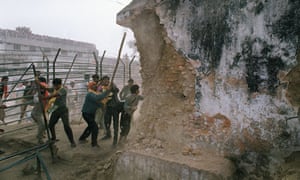
 The dispute over the 16th-century Babri mosque, in Ayodhya, goes back decades. In December 1992, Hindu militants razed the mosque, which is on a disputed religious site in the Indian state of Uttar Pradesh, triggering clashes with Muslims that left 2,000 people dead and plunged the country into political crisis. In a Guardian article dated 3 December, Derek Brown describes mounting political tension as Hindu holy men decide whether to press ahead with construction of a temple on the site of the mosque, which they believe to be also the birthplace of the deity Lord Ram. The Indian government is bracing itself for confrontation with Hindu zealots, Brown writes, as it deploys paramilitary forces to protect the 460- year-old Babri Masjid mosque of the Moghul emperor, Babar. "What began as an arcane religious squabble has in recent years become the most intractable dispute in India," he says. Three days later, the state government falls as "a baying mob of Hindu bigots" tears down the mosque, where they want to build a temple. "They used primitive tools and their bare hands to tear the mosque to pieces," writes Brown. "First the three domes went, then the spartan interior and the perimeter walls. The Hindu idols, installed in the late 1940s at the start of the arcane, obscurantist dispute, also disappeared ... In a few frenzied hours, the mob brought down the government of India's most populous state, and provoked deep communal tension throughout the country." On 8 December, Brown describes how riots have erupted the length and breadth of "a huge and angry country". Even Bombay, the great western metropolis considered the most modern of Indian cities, is caught up in the violence, which leaves more than 200 people dead. Elsewhere in that day's paper, Brown analyses the events leading up the confrontation. To the despair of educated Indians "ingrained with a notion of their country as steeped in the non- violence of Gandhi", he says, Ayodhya had been an explosion waiting to happen after Rajiv Gandhi, the then prime minister, ordered that a makeshift temple built on the site just after independence in 1947 should be reopened, as a sop to Hindu extremists. The temple went on to be become a rightwing and nationalist cause for the fast-growing Bharatiya Janata party, Brown writes. The Guardian, December 3 1992. Click image to read the archive article The Guardian, December 7 1992. Click image to read the archive article The Guardian, December 8 1992. Click image to read the archive article
The dispute over the 16th-century Babri mosque, in Ayodhya, goes back decades. In December 1992, Hindu militants razed the mosque, which is on a disputed religious site in the Indian state of Uttar Pradesh, triggering clashes with Muslims that left 2,000 people dead and plunged the country into political crisis. In a Guardian article dated 3 December, Derek Brown describes mounting political tension as Hindu holy men decide whether to press ahead with construction of a temple on the site of the mosque, which they believe to be also the birthplace of the deity Lord Ram. The Indian government is bracing itself for confrontation with Hindu zealots, Brown writes, as it deploys paramilitary forces to protect the 460- year-old Babri Masjid mosque of the Moghul emperor, Babar. "What began as an arcane religious squabble has in recent years become the most intractable dispute in India," he says. Three days later, the state government falls as "a baying mob of Hindu bigots" tears down the mosque, where they want to build a temple. "They used primitive tools and their bare hands to tear the mosque to pieces," writes Brown. "First the three domes went, then the spartan interior and the perimeter walls. The Hindu idols, installed in the late 1940s at the start of the arcane, obscurantist dispute, also disappeared ... In a few frenzied hours, the mob brought down the government of India's most populous state, and provoked deep communal tension throughout the country." On 8 December, Brown describes how riots have erupted the length and breadth of "a huge and angry country". Even Bombay, the great western metropolis considered the most modern of Indian cities, is caught up in the violence, which leaves more than 200 people dead. Elsewhere in that day's paper, Brown analyses the events leading up the confrontation. To the despair of educated Indians "ingrained with a notion of their country as steeped in the non- violence of Gandhi", he says, Ayodhya had been an explosion waiting to happen after Rajiv Gandhi, the then prime minister, ordered that a makeshift temple built on the site just after independence in 1947 should be reopened, as a sop to Hindu extremists. The temple went on to be become a rightwing and nationalist cause for the fast-growing Bharatiya Janata party, Brown writes. The Guardian, December 3 1992. Click image to read the archive article The Guardian, December 7 1992. Click image to read the archive article The Guardian, December 8 1992. Click image to read the archive article
Watch Videos
Part:1
Part:2
Part:3
Part:4 [youtube="NuKWw9B6TtE"PC5iztcMLw0
Part:5
Part:6
No comments:
Post a Comment